Top 10 Applications of AI
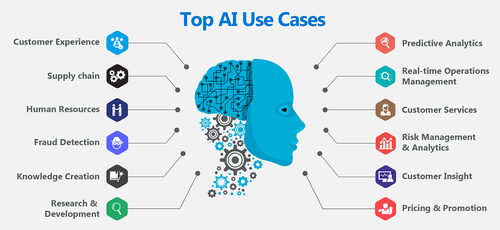
In the rapidly evolving landscape of technology, Artificial Intelligence (AI) has emerged as a transformative force, reshaping industries and revolutionizing the way we interact with the world around us and is being applied across various fields to enhance efficiency, accuracy, and innovation. From healthcare to finance, from manufacturing to entertainment, AI applications are proliferating and making a profound impact on diverse sectors. In this article, we delve into the top 10 AI applications that are reshaping industries and driving innovation.
1. AI in Healthcare
AI is driving a transformative shift that promises to make healthcare more accessible, accurate, and effective than ever before. From aiding clinicians in diagnosing complex diseases to optimizing treatment plans and enhancing patient experiences.
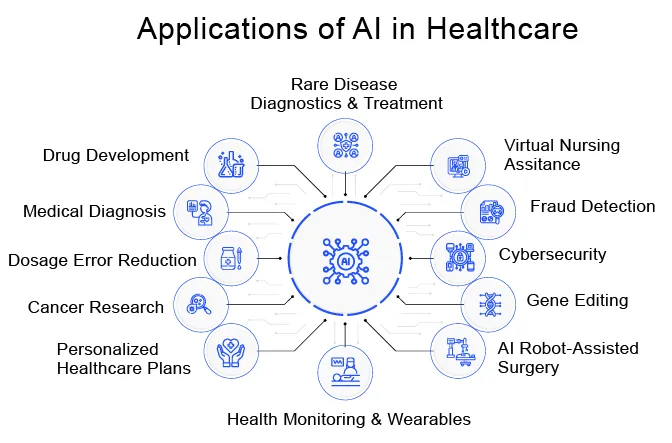
AI's Role in Diagnostics
- Medical Imaging Interpretation: AI algorithms analyze medical images like X-rays, MRIs, and CT scans, detecting anomalies that may go unnoticed by human eyes helping radiologists identify conditions such as tumors, fractures, and cardiovascular issues with greater accuracy. It can accurately identify early signs of diseases like cancer, expediting diagnosis and treatment.
- Pathology and Histology: AI aids pathologists by analyzing tissue samples, identifying cancerous cells, and classifying diseases, thereby expediting the diagnostic process.
- Early Disease Detection: AI-powered predictive models analyze patient data to identify early signs of diseases, enabling proactive interventions and preventing disease progression.
Enhancing Treatment Approaches
- Personalized Treatment: Personalized treatment, also known as precision medicine, revolves around the idea that each patient is unique, and their medical care should reflect this individuality. Traditionally, medical treatments have been developed based on generalized guidelines, but these guidelines may not account for the intricate interplay of genetic, environmental, and lifestyle factors that influence a patient's health. AI analyzes patient data, including genetic information, to tailor treatment plans based on individual characteristics, optimizing efficacy and minimizing adverse effects. AI-driven personalized treatment aims to bridge this gap by leveraging advanced algorithms to analyze vast amounts of data and provide tailored medical interventions and offering hope and improved health outcomes for countless individuals around the world.
- Drug Discovery and Development: AI accelerates drug discovery by simulating molecular interactions, predicting potential drug candidates, and shortening the research and development process.
- Clinical Decision Support: AI assists healthcare providers by offering evidence-based treatment recommendations, considering vast datasets to suggest the most effective interventions.
Improving Patient Care
- Remote Monitoring: AI-enabled wearables and IoT devices track patients' vital signs and health metrics, enabling real-time monitoring and timely medical interventions.
- Predictive Analytics: AI forecasts patient outcomes and identifies those at risk of complications, enabling healthcare professionals to allocate resources efficiently.
- Virtual Health Assistants: AI-powered chatbots and virtual assistants offer patients round-the-clock access to medical information, answer queries, and even schedule appointments.
Real-World Success Stories
- IBM Watson for Oncology: AI assists oncologists in developing personalized cancer treatment plans by analyzing vast amounts of medical literature and patient data.
- Google's DeepMind AI: AI algorithms analyze retinal scans to detect signs of diabetic retinopathy, enabling early detection and intervention.
- PathAI: AI-powered pathology platform helps pathologists interpret and diagnose diseases from tissue samples with higher precision.
2. AI in Finance
The integration of AI in finance is reshaping the industry, from optimizing investment and trading strategies to risk management and customer interactions.
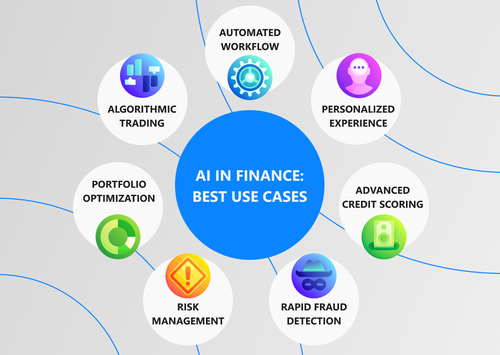
AI in Investment and Asset Management
- Algorithmic Trading: AI-powered algorithms analyze market data, patterns, and historical trends to execute trades at speeds and volumes beyond human capabilities, resulting in optimized execution and reduced market impact.
- Portfolio Management: AI-driven systems create and manage investment portfolios, dynamically adjusting asset allocations based on market conditions and investor preferences.
- Risk Assessment: AI assesses risks by analyzing vast datasets, market sentiment, and geopolitical factors, providing accurate risk predictions and aiding in informed investment decisions.
AI-Powered Trading Strategies
- Quantitative Trading: AI algorithms analyze massive datasets to identify market inefficiencies and generate quantitative models that inform trading strategies.
- High-Frequency Trading (HFT): AI facilitates lightning-fast trades by processing real-time market data and executing orders within microseconds.
- Sentiment Analysis: AI processes news, social media, and other textual data to gauge market sentiment, helping traders anticipate market movements.
Risk Management and Fraud Detection
- Credit Scoring: AI algorithms analyze borrower data to assess creditworthiness, improving accuracy and efficiency in loan approvals.
- Fraud Detection: AI detects anomalies in transactions and patterns indicative of fraud, enabling real-time prevention and mitigation.
- Market Surveillance: AI monitors trading activities, identifying suspicious behavior and potential market manipulation.
Real-World Success Stories
- Robo-Advisors: Platforms like Betterment and Wealthfront use AI algorithms to manage investment portfolios, offering cost-effective and personalized financial advice to users.
- Credit Scoring: Companies like Upstart employ AI to assess borrower creditworthiness, providing loans to underserved individuals with unconventional credit histories.
- Fraud Prevention: Financial institutions like JPMorgan Chase utilize AI to detect fraudulent transactions and prevent unauthorized access to accounts.
3. AI in Retail
AI technologies have enabled retailers to enhance various aspects of their operations, from personalized customer experiences to supply chain optimization.
AI-Driven Customer Experiences
- Personalized Recommendations: AI algorithms analyze customer data, browsing history, and purchase patterns to provide tailored product recommendations, enhancing cross-selling and upselling.
- Chatbots and Virtual Assistants: AI-powered chatbots offer real-time customer support, answer queries, and guide shoppers through their purchase journey, enhancing customer engagement.
- Visual Search: AI enables shoppers to search for products using images, enhancing convenience and streamlining product discovery.
Supply Chain Optimization
- Demand Forecasting: AI analyzes historical sales data, external factors, and market trends to predict product demand, aiding in inventory management and reducing stockouts.
- Inventory Management: AI optimizes inventory levels, minimizing carrying costs and ensuring products are available when and where they are needed.
- Supplier Management: AI analyzes supplier performance data to identify the most reliable and cost-effective partners, enhancing supply chain resilience.
AI-Powered Marketing and Advertising
- Behavioral Analytics: AI analyzes customer behavior to identify patterns and preferences, enabling targeted marketing campaigns and personalized offers.
- Dynamic Pricing: AI algorithms adjust prices based on real-time demand, competition, and market conditions, maximizing revenue and optimizing pricing strategies.
- Predictive Analytics: AI predicts consumer trends and preferences, guiding marketing strategies and ensuring relevant and timely campaigns.
Enhancing In-Store Experiences
- Smart Shelves and Carts: AI-equipped shelves detect product levels and communicate with shoppers' devices, providing real-time information and enhancing convenience.
- Checkout-Free Stores: AI-powered systems enable frictionless shopping experiences by automatically detecting items in a shopper's cart and charging them upon exit.
Real-World Success Stories
- Amazon Go: Amazon's checkout-free stores use AI and sensors to enable seamless shopping experiences, eliminating the need for traditional checkouts.
- Sephora Visual Artist: Sephora's AI-powered app uses augmented reality to allow customers to virtually try on makeup products before making a purchase.
- Walmart's Intelligent Retail Lab: Walmart utilizes AI to monitor inventory levels and product availability in real-time, optimizing store operations.
4. AI in Agriculture
AI technologies with agricultural practices promises to address the challenges of feeding a growing global population, ensuring food security, and minimizing the environmental impact of farming.
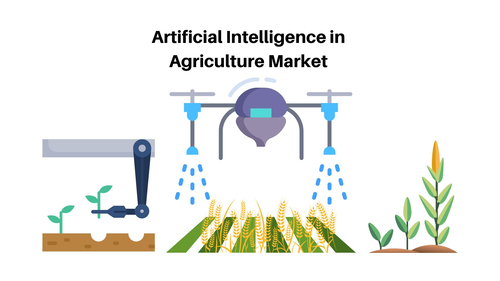
Precision Agriculture and Smart
- Remote Sensing: AI processes data from satellites, drones, and sensors to monitor crop health, detect diseases, and assess soil moisture levels.
- Crop Monitoring: AI algorithms analyze imagery to identify growth patterns, predict yield potential, and optimize irrigation and fertilizer application.
- Predictive Analytics: AI models forecast weather conditions, enabling farmers to make informed decisions about planting, harvesting, and pest control.
Efficient Resource Management
- Water Management: AI-driven irrigation systems optimize water usage by monitoring soil conditions and adjusting irrigation based on real-time data.
- Precision Spraying: AI-equipped drones and vehicles target specific areas for pesticide and herbicide application, reducing chemical use and environmental impact.
- Crop Planning: AI algorithms recommend optimal crop rotations and varieties based on historical data and market demand, enhancing productivity and sustainability.
Livestock Monitoring and Health
- Animal Behavior Analysis: AI processes data from wearable devices and cameras to monitor livestock behavior, detect anomalies, and ensure animal welfare.
- Health Diagnosis: AI analyzes data to identify early signs of disease, enabling timely interventions and reducing the spread of illnesses.
Real-World Success Stories
- Blue River Technology:
- Ceres Imaging: Ceres utilizes AI to analyze aerial imagery, helping farmers manage water and nutrient usage efficiently.
5. AI in Manufacturing
AI in Manufacturing is redefining the way goods are produced and delivered, from optimizing production processes to enhancing product quality and reshaping supply chain management.
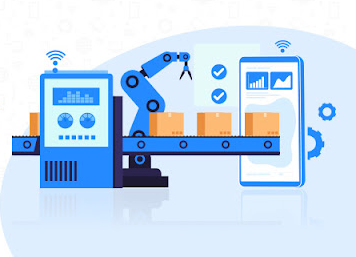
AI-Powered Predictive Maintenance
- Condition Monitoring: AI sensors and predictive analytics monitor equipment health in real-time, enabling early detection of potential failures and minimizing downtime.
- Anomaly Detection: AI algorithms analyze sensor data to identify unusual patterns, helping manufacturers proactively address issues before they escalate.
Enhancing Production Processes
- Process Optimization: AI analyzes production data to identify inefficiencies, bottlenecks, and areas for improvement, leading to streamlined workflows and reduced waste.
- Supply Chain Management: AI optimizes inventory levels, demand forecasting, and order fulfillment, ensuring timely availability of raw materials and finished products.
- Robotic Process Automation (RPA): AI-driven robots perform repetitive tasks with precision, improving productivity and freeing human workers for more complex roles.
Quality Control and Inspection
- Visual Inspection: AI-powered cameras and computer vision systems detect defects, inconsistencies, and deviations in manufacturing processes, ensuring product quality.
- Defect Prediction: AI algorithms analyze historical data to predict potential defects, enabling preemptive actions to maintain high-quality standards.
Real-World Success Stories
- Siemens: The company employs AI-driven simulations to optimize production processes, reducing energy consumption and improving efficiency.
- Foxconn: AI-powered robots work alongside human workers (cobots) in electronic manufacturing, enhancing production speed and precision.
- General Electric (GE): GE utilizes AI for predictive maintenance, analyzing sensor data from industrial equipment to anticipate maintenance needs and reduce downtime.
6. AI in Autonomous Vehicles
AI is revolutionizing transportation, promising safer roads, improved mobility, and a paradigm shift in how we interact with vehicles.
- Perception and Sensing: AI-powered sensors, cameras, and lidar systems enable vehicles to perceive their surroundings, identify objects, pedestrians, and other vehicles, and make real-time decisions based on the data.
- Decision-Making: Complex AI algorithms process sensor data, traffic conditions, and contextual information to make split-second decisions, ensuring safe and efficient navigation.
- Mapping and Localization: AI creates detailed maps and precisely locates the vehicle using GPS, sensors, and advanced algorithms, enabling accurate positioning and route planning.
- Advanced Driver Assistance Systems (ADAS): AI assists drivers with features like lane-keeping, adaptive cruise control, and parking assistance.
Real-World Success Stories
- Tesla Autopilot: Tesla's AI-powered Autopilot offers advanced driver-assistance features and uses AI algorithms for autonomous driving capabilities.
- Waymo: Alphabet's Waymo utilizes AI to develop self-driving technology, with a focus on Level 4 and 5 autonomous vehicles.
- Uber ATG: Uber's Advanced Technologies Group employs AI for self-driving technology, combining sensor data with machine learning for safe navigation.
7. AI in Energy
Collaborations between AI experts, energy professionals, and policymakers will be pivotal in harnessing its full potential to drive innovation, efficiency, and a cleaner energy landscape for generations to come.
AI for Renewable Energy Integration
- Solar and Wind Forecasting: AI analyzes weather data and historical patterns to predict solar and wind energy production, optimizing grid management and reducing reliance on traditional power sources.
- Energy Storage Optimization: AI algorithms manage energy storage systems, predicting demand and supply patterns to maximize the efficiency of battery and storage technologies.
- Smart Grid Management: AI monitors and controls the flow of electricity in smart grids, ensuring efficient distribution and minimizing power losses. It also monitor energy demand and adjust consumption patterns to match supply, reducing strain on the grid during peak times.
Real-World Success Stories
- Google DeepMind and AI for Data Center Cooling: Google's AI algorithms optimize data center cooling systems, reducing energy consumption and costs.
- ABB Ability™ Smart Grid:ABB's AI-driven platform manages energy distribution, predicting demand and optimizing grid operations.
8. AI in Education
AI's integration into education is fostering a dynamic and learner-centered approach, reshaping the way knowledge is transmitted and acquired. By personalizing learning experiences, empowering educators, and facilitating inclusive education, AI is enhancing the quality and accessibility of education for diverse learners.
AI-Powered Personalized Learning
- Adaptive Learning Platforms: AI algorithms analyze student performance data to tailor learning paths, adjusting content and pace to individual needs and learning styles.
- Smart Content Creation: AI-generated content, such as quizzes and exercises, adapts to students' skill levels and provides instant feedback, promoting active learning.
- Language Learning: AI-driven language apps offer real-time pronunciation feedback and personalized exercises, facilitating language acquisition.
Enhancing Teaching and Assessment
- Automated Grading: AI evaluates assignments, essays, and multiple-choice tests, saving educators time and providing consistent and prompt feedback to students.
- Tutoring Assistants: AI-powered chatbots offer students instant support for academic queries, helping to reinforce concepts outside of classroom hours.
- Learning Analytics: AI analyzes student data to identify areas of improvement, enabling educators to tailor interventions and support.
Special Education and Inclusion
- Personalized Support for Students with Disabilities: AI assists students with special needs by adapting content and providing individualized learning experiences.
- Early Detection of Learning Challenges: AI analyzes student behavior and performance patterns to identify learning difficulties, enabling timely interventions.
Real-World Success Stories
- Squirrel AI: This AI-driven tutoring platform customizes learning paths and content for students, achieving improved learning outcomes.
- Duolingo: Duolingo's AI-powered language app adapts lessons and exercises to learners' strengths and weaknesses, facilitating language acquisition.
9. AI in Entertainment
AI's integration into the entertainment industry is redefining how content is created, consumed, and experienced. By enhancing creativity, personalizing experiences, and enabling new forms of interaction.
AI-Powered Content Creation
- Scriptwriting and Storytelling: AI algorithms analyze existing scripts and patterns to generate plotlines, characters, and dialogue, providing inspiration and ideas to creators.
- Music Composition: AI systems compose original music tracks based on style preferences and mood specifications, expanding the possibilities of musical creation.
- Visual Effects: AI-driven tools enhance post-production processes by automating tasks like rotoscoping, background removal, and scene enhancement.
Enhancing Post-Production and Editing
- Automated Editing: AI streamlines the editing process by analyzing footage, suggesting cuts, and optimizing sequences, saving time and effort for creators.
- Voice Synthesis: AI-generated voiceovers and dubbing provide multilingual options and seamless integration of voice content.
Real-World Success Stories
- OpenAI's Jukebox: Jukebox is an AI model that generates music tracks in various styles and genres, showcasing AI's potential in music composition.
- Netflix and Content Recommendation: Netflix uses AI algorithms to recommend personalized content to viewers based on their viewing history and preferences.
10. AI in Natural Language Processing (NLP)
Natural Language Processing (NLP) stands at the forefront of Artificial Intelligence (AI) innovation, transforming the way we communicate, understand, and interact with technology.
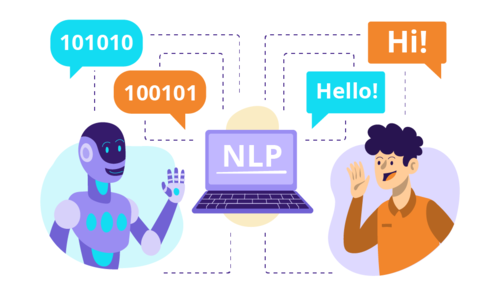
Language Understanding and Processing
- Language Translation: AI-powered translation models, such as neural machine translation, accurately convert text between languages, breaking down language barriers.
- Sentiment Analysis: NLP algorithms analyze text to determine sentiment, helping businesses gauge public opinion, assess brand perception, and make data-driven decisions.
- Named Entity Recognition: AI identifies and classifies entities like names, dates, and locations in text, facilitating information extraction and content organization.
Voice Assistants and Chatbots
- Virtual Assistants: NLP-driven virtual assistants like Siri, Alexa, and Google Assistant understand voice commands, answer queries, and perform tasks.
- Chatbots: AI-powered chatbots engage in natural language conversations, providing customer support, information, and transactional services.
Text Generation and Summarization
- Text Generation: AI models like GPT-3 generate coherent and contextually relevant text, ranging from creative writing to programming code.
- Summarization: NLP algorithms create concise summaries of lengthy text, aiding in information retrieval and content digestion.
Real-World Success Stories
- Google Translate: Google's NLP-powered translation service provides accurate and context-aware translations for millions of users.
- Amazon Alexa: Alexa is an AI-powered virtual assistant that operates through voice commands, capable of controlling smart home devices, playing music, and providing information.
The top 10 AI applications discussed in this article merely scratch the surface of AI's potential. As technology continues to advance, the boundaries of what AI can achieve will expand, leading to further innovation and transformative applications across industries. However, as we embrace the boundless opportunities AI presents, it's crucial to navigate the ethical, privacy, and societal implications that come with this rapid advancement. As we stand on the precipice of an AI-driven era, the fusion of human creativity and machine intelligence promises a future where innovation knows no bounds, and the limits of what we can achieve are only constrained by the boundaries of our imagination.
Join Famark Community!
Famark community is a social platform for creative and innovative professionals from different domains.
Join Community